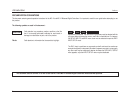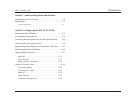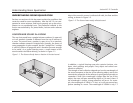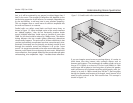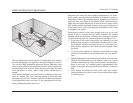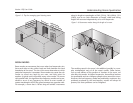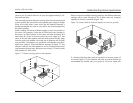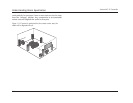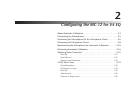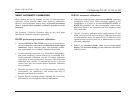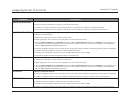
Understanding Room Equalization
1-6
Lexicon MC-12 Controller
Room modes affect the frequency response you hear in several
ways. The most pronounced effect of room modes is to make cer-
tain frequencies too loud. You can correct this to some degree with
an equalizer. Strong resonances have an additional feature: those
frequencies linger on. When a speaker creates sound at the fre-
quency of a strong resonance mode, that sound lingers in the room
after the speaker has stopped vibrating. For a very strong reso-
nance, the sound could linger as long as half a second. In the worst
cases, that sound will also have a distinct pitch.
Listeners do not always notice this “extra” sound because the fre-
quencies of stable modes are usually too low to be discernible as a
detail unless the listener specifically listens for them. Rather, the
usual problem is that the lingering sound can obscure other parts
of the music. For example, the lingering sound from a kick drum
could mask the details of a following vocal passage. Subjectively,
you might feel as if you were listening to the music through a layer
of gauze. You might try to fix things by turning up the overall vol-
ume, turning down the overall volume, or by tweaking your audio
controls (bass, treble, tilt EQ, or loudness). However, none of these
fixes can provide satisfactory results. For example, turning down
the bass sufficiently to solve the problem with the kick drum will
probably leave all the low frequencies seemingly too low in ampli-
tude. By comparison, were you to listen to the same recording
through headphones (headphones eliminate room modes, since
they are tightly coupled to the ear), you wouldn’t have the prob-
lem. You might then describe the sound of the same recording
played back in your room as having “flabby bass,” and assume the
cause is your system or your speakers. In fact, if you are really hear-
ing room modes the flabby bass is not caused by your speakers; it
is caused by your room.
The too-slow decay of a resonance mode can be corrected only by
applying the proper filter. The severity of a resonance mode is
defined by its “Q” value (which historically meant Quality Factor).
The higher the Q of a resonance, the bigger its amplitude and the
slower its decay.
The presence of a resonance with high Q is not a desirable condi-
tion in listening rooms. Proper treatment of a resonance requires a
filter with not only the correct frequency and depth, but also the
correct Q. Graphic equalizers offer neither a variety of Q values nor
a fine enough frequency selection. A good parametric equalizer can
be made to work, but you would first need to have the expertise
and equipment to measure the room's resonances. This could be a
difficult and time-consuming task.
The V4 EQ procedure identifies room resonances and measures
both their Q and frequency in a highly precise manner. Using this
information, it then applies the proper parametric filters to neu-
tralize these resonances. You can run the V4 EQ procedure by fol-
lowing the simple set of instructions in section 2 of this user guide.
Surround Sound Issues
Surround sound is a key component of modern multimedia pre-
sentations. An action-movie DVD may have great video, but the
moving image of an explosion offers little thrill to the viewer with-
out an accompanying BOOM! A tire-screeching vehicle entering
the field of view from the left is more effective if the accompanying
audio comes from the left also. The surround sound system is what
makes it all work. Properly setting up a surround sound system is
essential. In most installations, the seating positions pose a bigger
problem than the system setup.
The two key adjustments for each speaker are timing and level. The
subtle differences in timing of the sound coming out of each of sev-
eral speakers is what gives you (the listener) a sense of direction.
These subtle timing differences can be as short as a few millisec-
onds. If you are too close to one speaker in the system, many of the
audio effects will seem to come from only that direction because
the sound from that speaker arrives at your ears too early. Since
sound travels a bit faster than 1100 feet per second, each foot of
travel takes just under a millisecond. So if one speaker is 5 feet too



